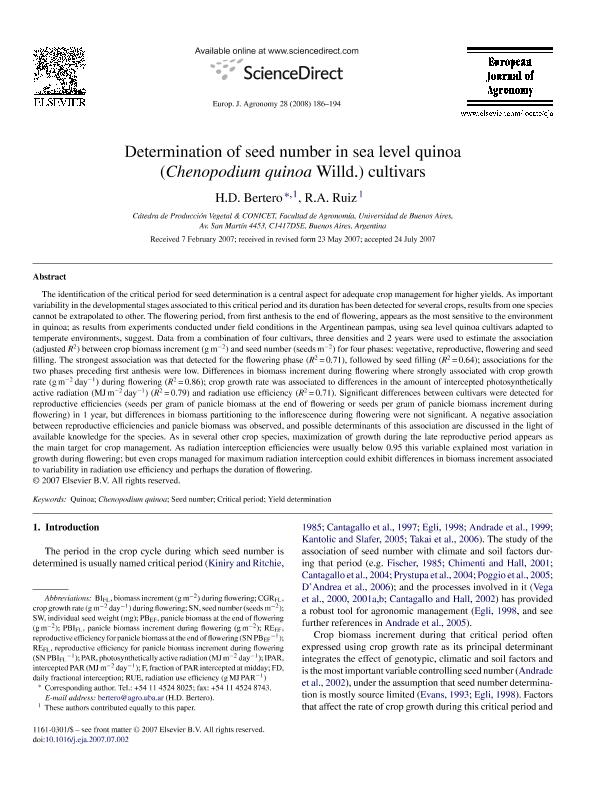Mostrar el registro sencillo del ítem
dc.contributor.author
Bertero, Hector Daniel

dc.contributor.author
Ruiz, R. A.
dc.date.available
2021-05-03T14:16:58Z
dc.date.issued
2008-04
dc.identifier.citation
Bertero, Hector Daniel; Ruiz, R. A.; Determination of seed number in sea level quinoa (Chenopodium quinoa Willd.) cultivars; Elsevier Science; European Journal of Agronomy; 28; 3; 4-2008; 186-194
dc.identifier.issn
1161-0301
dc.identifier.uri
http://hdl.handle.net/11336/131244
dc.description.abstract
The identification of the critical period for seed determination is a central aspect for adequate crop management for higher yields. As important variability in the developmental stages associated to this critical period and its duration has been detected for several crops, results from one species cannot be extrapolated to other. The flowering period, from first anthesis to the end of flowering, appears as the most sensitive to the environment in quinoa; as results from experiments conducted under field conditions in the Argentinean pampas, using sea level quinoa cultivars adapted to temperate environments, suggest. Data from a combination of four cultivars, three densities and 2 years were used to estimate the association (adjusted R2) between crop biomass increment (g m-2) and seed number (seeds m-2) for four phases: vegetative, reproductive, flowering and seed filling. The strongest association was that detected for the flowering phase (R2 = 0.71), followed by seed filling (R2 = 0.64); associations for the two phases preceding first anthesis were low. Differences in biomass increment during flowering where strongly associated with crop growth rate (g m-2 day-1) during flowering (R2 = 0.86); crop growth rate was associated to differences in the amount of intercepted photosynthetically active radiation (MJ m-2 day-1) (R2 = 0.79) and radiation use efficiency (R2 = 0.71). Significant differences between cultivars were detected for reproductive efficiencies (seeds per gram of panicle biomass at the end of flowering or seeds per gram of panicle biomass increment during flowering) in 1 year, but differences in biomass partitioning to the inflorescence during flowering were not significant. A negative association between reproductive efficiencies and panicle biomass was observed, and possible determinants of this association are discussed in the light of available knowledge for the species. As in several other crop species, maximization of growth during the late reproductive period appears as the main target for crop management. As radiation interception efficiencies were usually below 0.95 this variable explained most variation in growth during flowering; but even crops managed for maximum radiation interception could exhibit differences in biomass increment associated to variability in radiation use efficiency and perhaps the duration of flowering.
dc.format
application/pdf
dc.language.iso
eng
dc.publisher
Elsevier Science

dc.rights
info:eu-repo/semantics/openAccess
dc.rights.uri
https://creativecommons.org/licenses/by-nc-sa/2.5/ar/
dc.subject
CHENOPODIUM QUINOA
dc.subject
CRITICAL PERIOD
dc.subject
QUINOA
dc.subject
SEED NUMBER
dc.subject
YIELD DETERMINATION
dc.subject.classification
Silvicultura

dc.subject.classification
Agricultura, Silvicultura y Pesca

dc.subject.classification
CIENCIAS AGRÍCOLAS

dc.title
Determination of seed number in sea level quinoa (Chenopodium quinoa Willd.) cultivars
dc.type
info:eu-repo/semantics/article
dc.type
info:ar-repo/semantics/artículo
dc.type
info:eu-repo/semantics/publishedVersion
dc.date.updated
2021-04-19T14:26:03Z
dc.journal.volume
28
dc.journal.number
3
dc.journal.pagination
186-194
dc.journal.pais
Países Bajos

dc.journal.ciudad
Amsterdam
dc.description.fil
Fil: Bertero, Hector Daniel. Consejo Nacional de Investigaciones Científicas y Técnicas. Oficina de Coordinación Administrativa Parque Centenario; Argentina. Universidad de Buenos Aires. Facultad de Agronomía. Departamento de Producción Vegetal. Cátedra de Producción Vegetal; Argentina
dc.description.fil
Fil: Ruiz, R. A.. Universidad de Buenos Aires. Facultad de Agronomía. Departamento de Producción Vegetal. Cátedra de Producción Vegetal; Argentina
dc.journal.title
European Journal of Agronomy

dc.relation.alternativeid
info:eu-repo/semantics/altIdentifier/doi/https://doi.org/10.1016/j.eja.2007.07.002
dc.relation.alternativeid
info:eu-repo/semantics/altIdentifier/url/https://www.sciencedirect.com/science/article/pii/S1161030107000895
Archivos asociados
